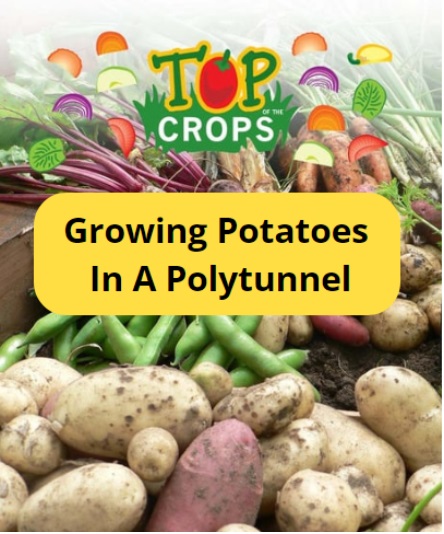Welcome to Top of the Crops. Today, you will learn everything that there is to know about growing potatoes in a polytunnel in the UK!
Potatoes are a staple crop and one of the most important sources of carbohydrate in the British diet. Fortunately, this is a crop that is relatively easy to grow yourself at home. No matter how much space you have available, you should be able to give it a go.
Potatoes, Solanum tuberosum, are a new world crop that came to the British Isles from South America during the period of Columbian Exchange.
Millennia of selection and breeding mean that there are, today, thousands of different cultivars or varieties to choose from, around 80 of which are commonly available here in the UK.
| Jan | Feb | Mar | Apr | May | Jun | Jul | Aug | Sep | Oct | Nov | Dec | |
| Plant |  |
 |
 |
|||||||||
| Harvest |  |
 |
 |
 |
 |
Potatoes are very easy to grow. But in order to grow them successfully you definitely need to understand what conditions they need to thrive. For best results, potatoes need:
An open position, ideally in full sun, free from spring frosts.
A rich, fertile soil or growing medium that is moist yet free draining.
Consistent water through the growing season.
Potatoes can be grown in the ground, or in containers where space is limited. Container growing can also allow potatoes to be brought undercover so that they can be grown on for Christmas potatoes.
Choosing the right location to grow potatoes is important, whether you are growing them in the ground or in containers.
As with other crops, it can be beneficial to consider where you place them not only through thinking about their own basic needs, but also considering how they fit into an overall garden plan. Companion planting can also be key to achieving the best results.
To grow potatoes you will need:
Seed potatoes.
Good, fertile soil or potting mix.
A spade and garden fork for planting, earthing up and harvesting.
Organic mulch material.
The process of growing potatoes is relatively simple and straightforward. To grow your own potatoes you should:
Choose which variety of potato to grow and source your seed potatoes.
Chit potatoes to prepare them for planting.
Plant seed potatoes in the ground or in containers in a suitable location.
Earth up/ mulch around your potato plants as they grow.
Harvest your potatoes and store or preserve them as required.
Potatoes in the uk are usually divided into three categories based on when they are planted and when they are harvested.
There are first earlies, second earlies, and maincrop varieties. Some examples of named cultivars in each of these categories are given below – though of course there are many, many more that you might choose from.
| First Earlies | Second Earlies | Maincrop |
| Swift | Charlotte | Maris piper |
| Maris Bard | Kestrel | Pink fir apple |
| Foremost | Jazzy | Ratte |
| Annabelle | Nadine | Sarpo mira |
| Casablanca | Maris Peer | Desiree |
In addition to thinking about whether you are looking for a first early, second early or maincrop type, choosing the right potatoes also means looking at which varieties might do well in the particular area where you live, and also what each of the different varieties is usually used for.
Some potatoes are better suited to cultivation in more northern or wetter gardens, while others will do best in the south. Some are best for baking, mashing or frying, others best for salads... etc... Of course, potatoes can differ greatly in their size, shape, texture and colour. It is a good idea to bear all these things in mind when choosing which ones to grow.
For many gardeners, the process of growing the seed potatoes they have purchased begins not outside in the garden, but indoors, early in the year, when they start chitting their potatoes.
There is a lot of debate about whether or not this process of letting the potatoes form green shoots before they are planted out actually makes a difference. But in my opinion it can be beneficial, especially for first early potatoes – speeding along the process and bringing forward the harvest just a little.
To chit seed potatoes, you simply leave them with eyes upwards in a bright but cool location. Green shoots will grow from the eyes, giving the tubers a small head-start when they are actually placed out into the ground or the containers where they are to grow.
I pop first earlies in old egg boxes on a north facing windowsill in an unheated room early in the new year, before planting those tubers in the polytunnel garden around a month to six weeks later.
Potatoes should be planted out at slightly different times depending on which type you are growing.
First earlies should typically be planted out in March.
Second earlies are planted out in early to mid April.
Maincrop varieties are planted from mid to late April on the whole.
Prepared tubers can also be planted out in July or early August for a Christmas crop.
The soil or growing medium should be rich with plenty of organic matter. It is also a good idea to mulch with organic matter upon planting.
First and second earlies should, as a guideline, be planted around 30cm apart, in rows 60cm apart.
Maincrop potatoes will need a bit more space, so are generally planted around 37cm-40cm apart, in rows 75cm apart.
It is traditional to plant potatoes in a trench, perhaps placing each tuber on top of some organic matter to boost early growth. I like to place some comfrey leaves in the base of a potato trench, for example.
If you are growing in containers, place one seed potato into a 30cm diameter pot. As a general rule of thumb, it is best to allow 10 litres of capacity for each seed potato that you plant.
So, in a container of 50 litres capacity, for example, you can plant 5 seed potatoes. This is just a rough guideline, but should help you begin to work out how many seed potatoes you can grow in the space available.
Be sure to read more on growing potatoes successfully in containers.
As potato plants grow, you should earth up, or pile soil or mulch around them. This helps prevent frost damage in spring and ensures developing potatoes are not spoiled by light.
Traditionally, you will mound soil around the stems when the plants reach around 20cm in height, to leave just the top half of the plant visible. This process is then repeated 2-3 more times so eventually mounds or ridges around 20-30cm high are formed around the plants. In containers, you will earth up too, so that the growing medium eventually reaches to just below the rim of the pot or other container you have chosen.
Keep plants well watered throughout the growing season, especially when the tubers are starting to form. Remember plants in pots will need more watering than those in the ground.
To ensure good fertility, use plenty of organic matter as mulch, and consider providing a nitrogen rich feed to maincrop types around the time of the second earthing up.
Protect young shoots from frost early in spring with cloches or fleece, or by covering with soil.
There are few hard and fast rules for determining when your first early or second early potatoes are ready to harvest. Some gardeners will say that potatoes are ready for harvest as soon as the plants flower, though this is not always a reliable sign, as sometimes there will be plenty of tubers to gather before there is any sign of flower buds.
Typically, however, first earlies will be harvested in June or July, second earlies in July or August.
Fortunately, you can check to see if the tubers have reached a reasonable size without uprooting the entire plant. Simply reach your hand gently into the soil around the base of the plant and feel around.
Often, you will be able to harvest a few of the earliest first earlies in this manner, without having to stop the plants from continuing to produce more tubers.
Gently feeling around under the soil can give you a good idea about how many tubers have formed and what sort of size they have reached, before you commit to lifting the plants.
Once you have determined that there are a quantity of worthwhile tubers to harvest, you can lift your plants. A number of tubers will likely be uprooted with the above-ground portion of the plant and can be gathered up.
However, after doing this, you should also delve into the soil and unearth other tubers that have remained in the ground. If the soil is friable enough, you can often do this with your hands. Though you can also carefully unearth your first early potatoes by turning over the area with a garden fork.
Make sure you get every tuber – those you do not harvest but leave in the ground will re-grow the following year. While this may sound like a good thing – leaving potatoes in the ground can cause a problem and spread diseases. It is best to make a clean sweep of it each year.
Maincrop potatoes can be ready to harvest from August, and will typically be ready some time in September, or possibly early October.
With maincrop potatoes that you would like to store for use over the months to come, it is best to wait until the foliage turns yellow, then cut it down and remove it.
After cutting back the fading foliage, you should wait 10 days to 2 weeks before harvesting the tubers.
(One thing to note, however, is that if potato blight takes hold, you might cut foliage earlier in order to prevent the spread of this fungal infection to the tubers, so may harvest earlier.)
Potatoes can be stored for later use in a range of ways. In this article, we share how to successfully store potatoes over the winter months.
Potatoes might not be the first crop you think to grow in a polytunnel, because they take up quite a lot of space and grow so easily outdoors.
But I find that growing first earlies in an unheated polytunnel can give an earlier harvest by a couple of weeks meaning that you can eat your own potatoes potentially from mid May. I grow mine alongside broad beans, and overwintered peas, which also give an early harvest. These are out of the way before the summer crops need to take their places. Be sure to also check out these delicious potato recipes.
BBC. (n.d.) 41 Potato Recipe Ideas. BBC Good Food. [online] Available at: https://www.bbcgoodfood.com/recipes/collection/potato-recipes [accessed 13/12/23]
